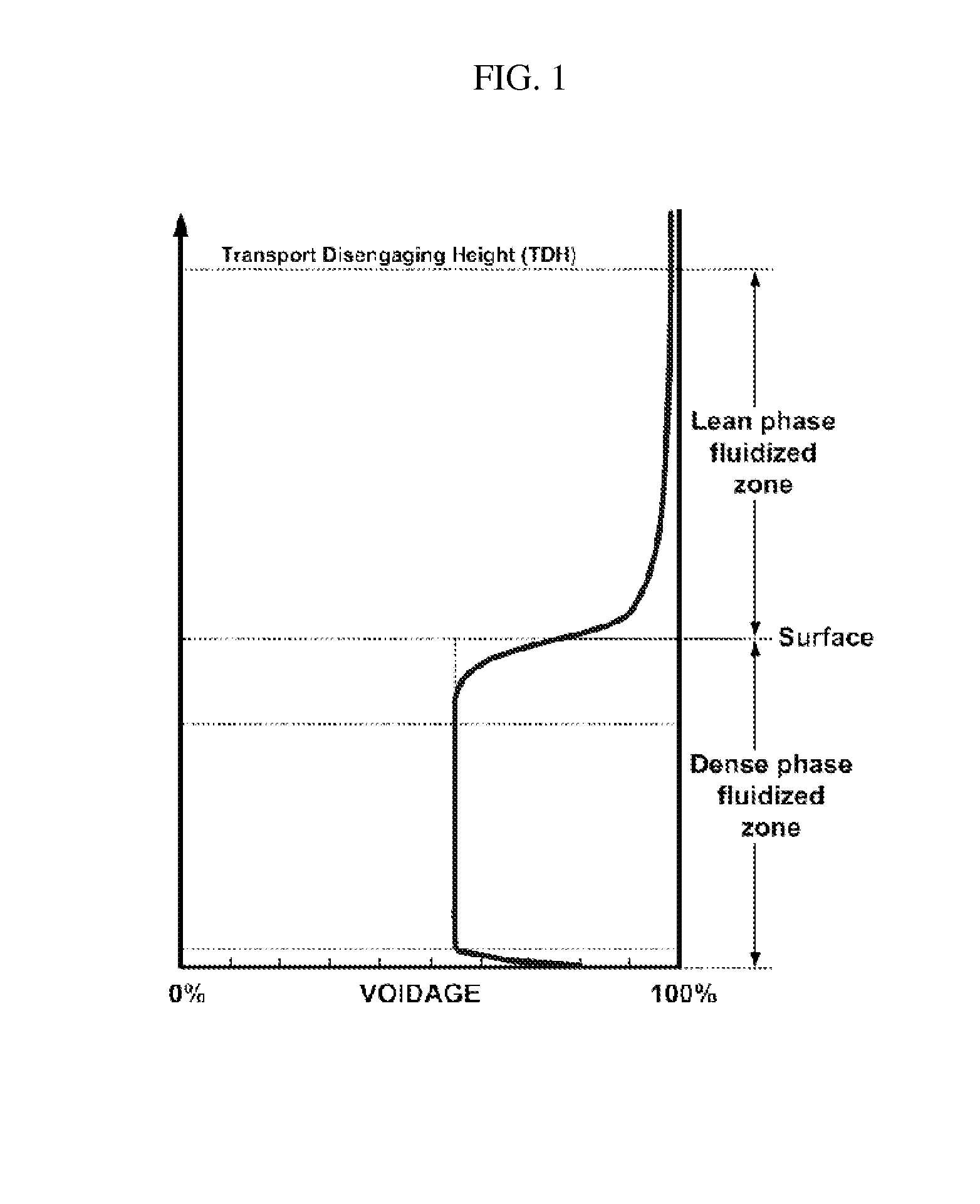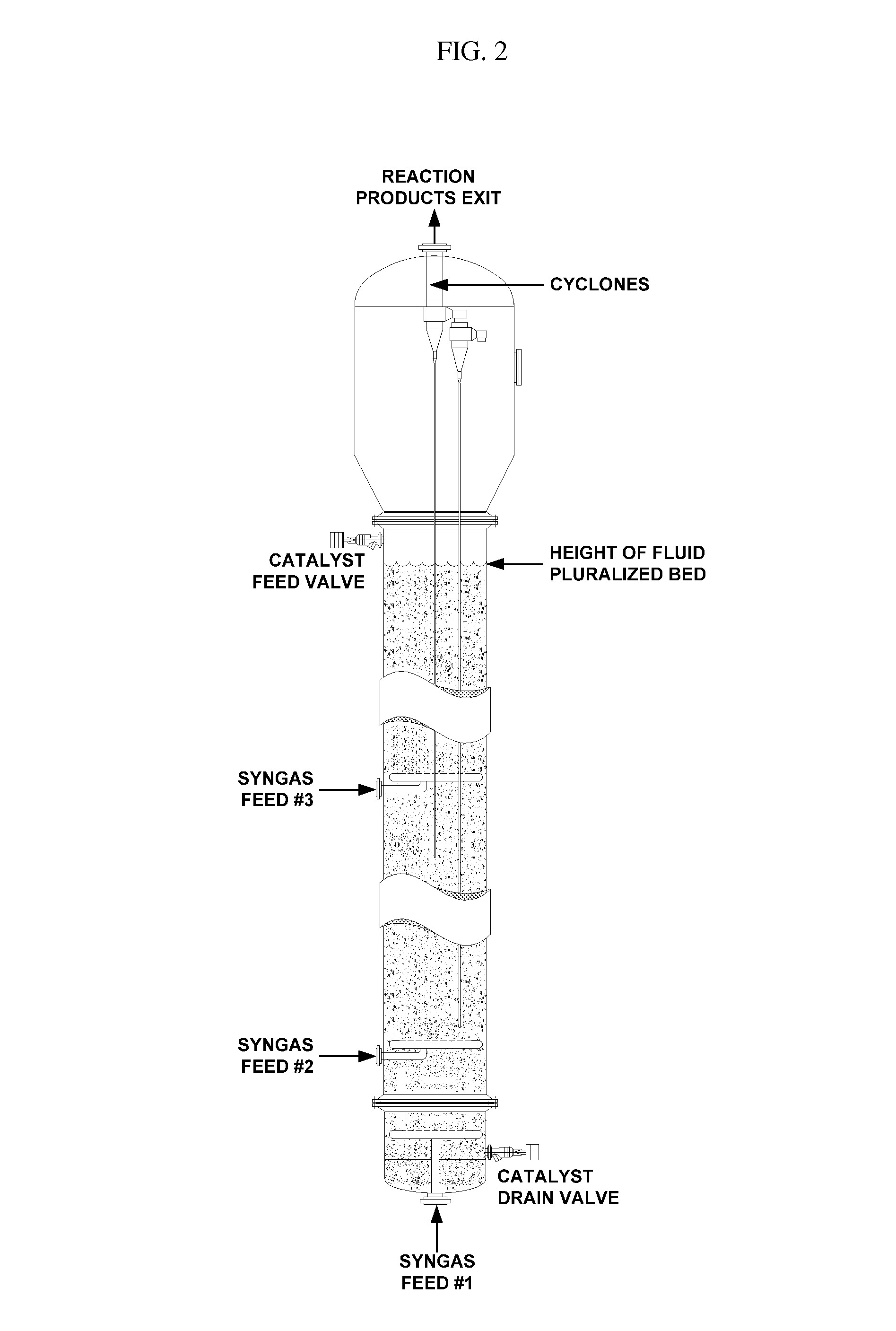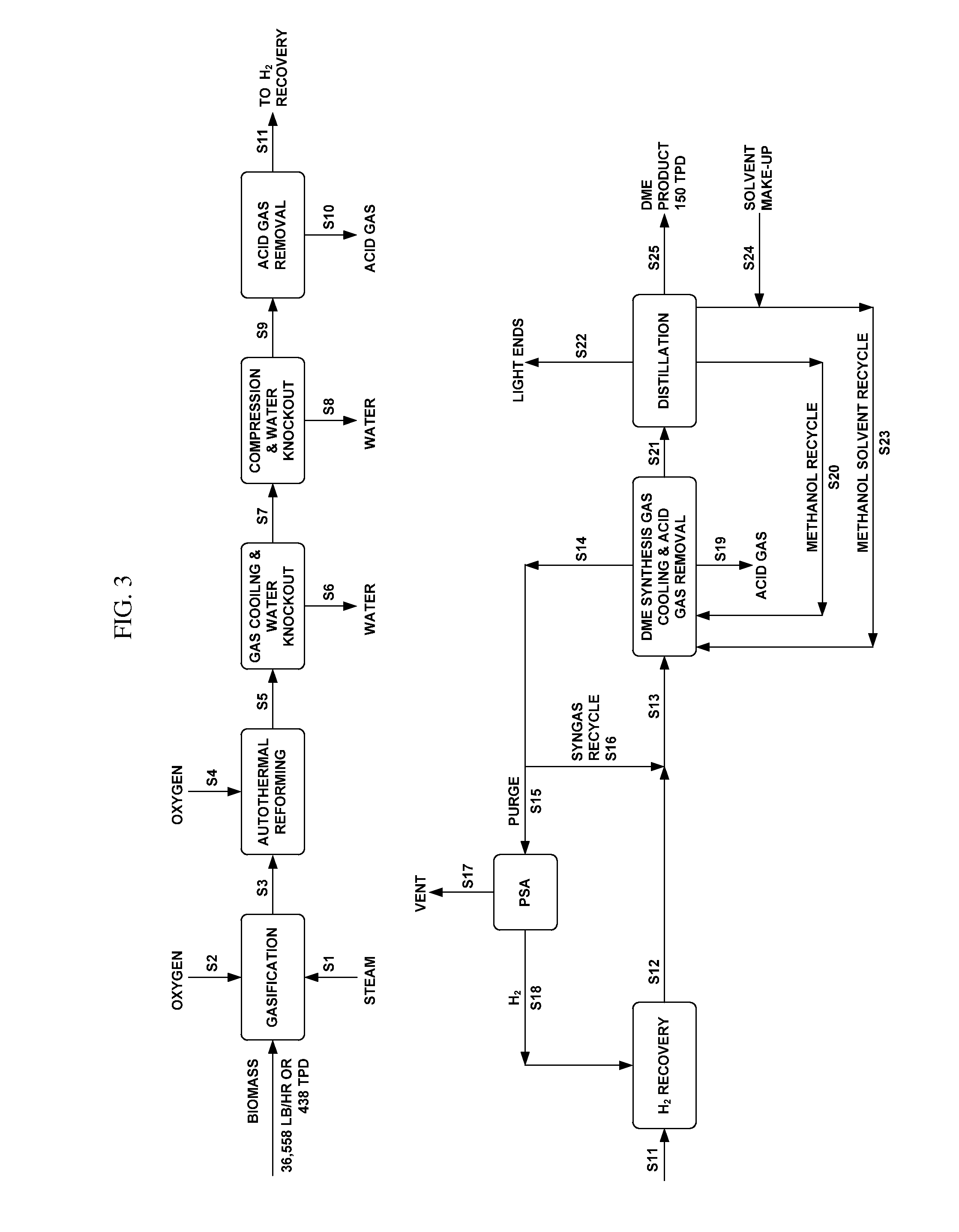Synthesis of DME using a fluid pluralized bed reactor
a technology of fluid pluralization and synthesis, which is applied in the direction of ether preparation, ether preparation, energy input, etc., can solve the problems of limited heat removal capability, low conversion rate of syngas, and limit the productivity of dme, so as to achieve uniform heat distribution, simplify kinetics, and pick up the effect of reaction hea
- Summary
- Abstract
- Description
- Claims
- Application Information
AI Technical Summary
Benefits of technology
Problems solved by technology
Method used
Image
Examples
example 1
[0082]36,358 lb / hr of biomass with the composition shown below is fed to a gasifier operated at 1750° F. and 150 psig.
[0083]
Biomass Proximate AnalysesComp.Wt %Moisture10.000Fixed Carbon11.954Volatiles83.400Ash4.646Total110.000
[0084]
Biomass Ultimate AnalysesComp.Wt %Carbon49.454Hydrogen5.755Nitrogen0.061Sulfur0.024Oxygen40.060Ash4.646Total100.000
[0085]An oxidative autothermal reformer operated at 1557° F. and 144 psig is provided for the simultaneous removal of tars, benzene / toluene / xylene components, and for decreasing methane concentration by reforming while optimizing energy efficiency. A syngas with the composition below is obtained:
[0086]
Syngas from Autothermal ReformerPhaseVaporTemp., ° F.1556.8Pressure, psig144.0Flowrate, lbmol / hr2637.62H2 / CO, Molar Ratio0.9560CompositionMol %CH42.00CO214.80N20.35H2O15.29CO34.54H233.02
[0087]This gas is then cooled down to 108° F. to knock out most of its moisture content before it is compressed by a two-stage compressor with intercooler, after...
example 2
[0103]Same as Example 1 except that the internal heat transmission tube in the fluid pluralized bed reactor is removed. A higher recycle rate (from 3536 μmol / hr to 6363 μmol / hr) in the DME synthesis loop is required to maintain the same effluent temperature of the DME reactor. This higher recycle rate is obtained by injecting more steam to the gasifier (from 239 μmol / hr to 378 μmol / hr). The H2 / CO molar ratio in the feed syngas to the DME reactor also increases from 1.4149 to 2.8088 due to the water gas shift reaction:
[0104]
Feed Gases to DME ReactorFeed Gas to DME ReactorExample 1Example 2PhaseVaporVaporTemp., ° F.47.539.5Pressure, psig710.5710.5Flowrate, lbmol / hr5302.728183.06H2 / CO Molar Ratio1.41492.8088Composition, Mol %CH413.9413.46CO24.874.91N27.705.89H2O0.000.00CO30.4019.86H243.0155.79CH4O0.060.07DME0.020.02
[0105]The higher recycle rate in the DME synthesis loop also reduces the partial pressure of the DME product in the phase separator, only 0.715 mol % of the DME produced is ...
example 3
[0113]Same as Example 2 except that the absorption solvent in the methanol absorber is replaced by CH3—O(—CH2—CH2—O)5—CH3 (C12H26O6). Due to the higher solubility of the syngas in C12H26O6, more biomass, oxygen and steam are required to produce the same amount of DME product:
[0114]
Rich Solvent from Methanol / C12H26O6 AbsorberRich Solvent from Methanol / C12H26O6 AbsorberExample 1Example 2Example 3PhaseLiquidLiquidLiquidTemp., ° F.35.134.332.0Pressure, psig710.5710.5710.5Flowrate, lbmol / hr3426.744533.332358.64Flowrate, # / hr114796151721479062Wt Ratio, wt %23.9631.67100.00Component Flow, lbmol / hrCH424.2427.9238.16CO2276.73283.49280.64N22.171.935.03H2O4.823.460.71CO4.783.8317.11H24.839.0842.24CH4O2944.283928.383.17DME164.89275.24271.58C6H26O60.000.001700.00
[0115]
FeedstocksFeedstocksExample 1Example 2Example 3Biomass (10 wt % moisture), TPD438445464Oxygen (98 mol % pure), TPD162164170Steam, TPD5282100
[0116]The absorption solvent C12H26O6 also has much higher molecular weight and boiling poi...
PUM
| Property | Measurement | Unit |
|---|---|---|
| temperatures | aaaaa | aaaaa |
| temperatures | aaaaa | aaaaa |
| particle size | aaaaa | aaaaa |
Abstract
Description
Claims
Application Information
 Login to View More
Login to View More - R&D
- Intellectual Property
- Life Sciences
- Materials
- Tech Scout
- Unparalleled Data Quality
- Higher Quality Content
- 60% Fewer Hallucinations
Browse by: Latest US Patents, China's latest patents, Technical Efficacy Thesaurus, Application Domain, Technology Topic, Popular Technical Reports.
© 2025 PatSnap. All rights reserved.Legal|Privacy policy|Modern Slavery Act Transparency Statement|Sitemap|About US| Contact US: help@patsnap.com



